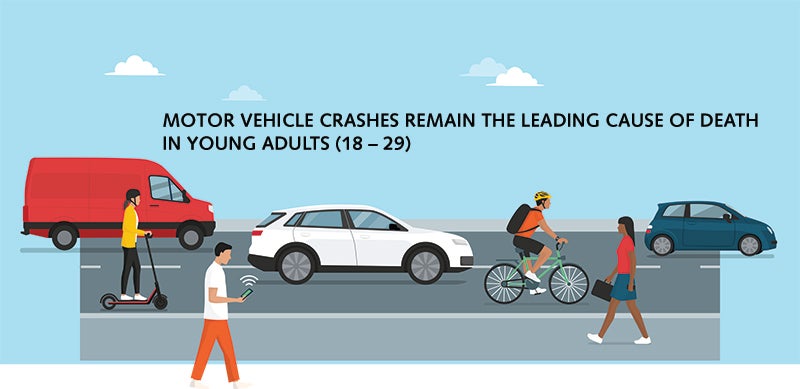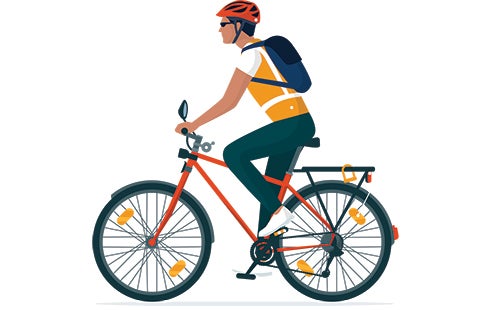Transportation Safety

Trauma is a leading cause of death and disability. Motor vehicle crashes are the most common and the most deadly traumatic injury in the US. While motor vehicle incidents are unpredictable, there are ways for people to remain safe and prevent injury and loss of life.
Bicycle Safety
Bicycle crashes result in injuries, such as bruises, cuts and broken bones. However, the most serious injury is a head injury. According to the CDC, 9 out of 10 riders who died as a result of a bike crash were not wearing a helmet.
-
 Wear a helmet. Wearing a helmet can decrease the risk of head injury by 88%.
Wear a helmet. Wearing a helmet can decrease the risk of head injury by 88%.
- Ride with traffic and do not swerve into oncoming traffic.
- Use hand signals to let others know what you plan to do.
- Follow traffic signs. Come to a complete stop at red lights and stop signs.
- Do not ride at dusk or after dark.
- Wear fluorescent or reflective clothing.
- Maintain active lighting on your bicycle.
Motorcycle Safety
Motorcyclists are 29 times more likely to die in a crash and 4 times as likely to be injured compared to passengers in motor vehicle crashes.
The single most effective way to reduce risk of injury or death in a motorcycle crash is to wear a helmet. Helmets reduce the risk of death by 37% and the risk of head injury by 69%.
Other Tips
- Get accustomed to your motorcycle by riding in a controlled area.
- Know how to handle your motorcycle in a variety of conditions and hazards (road debris, inclement weather, slick roads, etc.).
- Wear protective gear including a helmet and proper shoes.
- Check your motorcycle's tire pressure and tread depth, brakes, headlights and signals before each ride.
- Do not consume alcohol or drugs prior to riding.
Motor Vehicle Safety
Motor vehicle crashes are the number one cause of death in young adults and a significant cause of disability. There are ways to protect yourself and your passengers to prevent motor vehicle crashes. As always, a seatbelt is the most effective way to save lives and reduce injury in a crash.
- Keep tire tread, battery and brakes in good condition.
- Avoid driving late at night, as that is when drunk driving often occurs.
- Do not use alcohol or illicit substances prior to driving.
- Know what medications can affect your attention and avoid driving when using those medications.
- Travel in well-lit areas.
- Avoid distractions. Never use your phone behind the wheel.
- Follow speed limits.
- Avoid driving in inclement weather.
Pedestrian Safety
Motor vehicle crashes do not just result in injury for motorists but for pedestrians as well. As a pedestrian, there are ways to ensure your safety around other vehicles.
- Obey all traffic laws.
- Only walk on the sidewalk and designated paths for pedestrians.
- Never run into the street.
- Increase visibility at night by carrying a flashlight or wearing reflective clothing.
- Avoid distractions while crossing the street such as wearing headphones or using phone.
Some resources for you to explore:
- CDC’s My Mobility Plan for Older Adults
- Medications that could put you at risk if used while operating a vehicle
- Resources for ensuring child passenger safety
- SafeKids Wake County
- WakeMed Injury Prevention
- NC School Bus Safety
Information adapted from the Centers for Disease Control and Prevention (CDC), Child Injury Prevention Alliance and National Highway Traffic Safety Administration